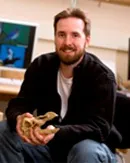Principle Investigators
Image

| Albert CrossDr. Albert Cross has spent 15+ years applying Magnetic Resonance Imaging methods to a wide variety of Solid state material, self-organizing Chemical and Biological systems. Dr. Cross has been the MRI Physicist at CCBN since July of 2005. MRI is a very versatile technique which is sensitive to the immediate molecular environment and motions of the nuclei which produces the signal. Axons are cells which have a long dimension and a short one. Since there is a large difference in the rate of movement of water along the axon as opposed to radially to the axon, diffusion encoded MRI sequences are able to map out the organized directions of axons in the brain even though each axon is much smaller than the pixel resolution of the MR Image. MRI also has the ability to look at the complex chemistry which is taking place in a living system. Dr. Cross· main interest is to use physical and chemical properties to encode within the image, information about the function and activity of the living Neuron. |
Image

| David EustonDamage to the prefrontal cortex, a part of the frontal lobes, can result in poor planning, unreasonable risk taking, and inappropriate social behaviour. The prefrontal cortex thus plays a crucial role in the decision making and emotional regulation that allow us, as humans, to function smoothly in our personal lives. The lives of rats are arguably simpler than our own, but they must solve many of the same everyday tasks as humans: deciding whom to fight and whom to befriend, knowing when to react in anger and when to appease, deciding when to keep searching (e.g., for food) or when to stay with what you have. Rats, too, have a prefrontal cortex which, anatomically, looks a lot like parts of the human prefrontal cortex and may serve a similar purpose. The functioning of this region in the rat's brain is the focus of David Euston's research. By looking at the activity of individual brain cells during complex decision-making tasks, Dr. Euston hopes to uncover how the prefrontal cortex integrates sensory input, memory, and emotional state to guide the rat in adaptive behaviour. Because many brain structures, including parts of the prefrontal cortex, are conserved across species, uncovering the computations served by the rat prefrontal cortex will hopefully shed light on the functioning of our own prefrontal cortex. |
Image

| Robbin GibbIt has been well established that early postnatal experience causes lasting changes in cerebral and behavioral organization in the rat but the details of how this happens are still poorly understood. Studies directed at the role of maternal experience in fetal brain development have focused mainly on the negative effects of inadequate nutrition, prenatal stress, and drug abuse. Dr. Gibb has conducted research to assess the potential utility of pre- and postnatal environmental stimulation to improve behavioral recovery after early cortical injury in rats. Her research has demonstrated that maternal tactile stimulation or complex housing has a prophylactic effect on later injury. Gibb has also demonstrated that the skin is capable of producing proteins like basic fibroblast growth factor (bFGF or FGF-2, a growth factor known to stimulate plasticity in brain) in response to tactile stimulation and these proteins appear to facilitate recovery from early-brain injury. The focus of Gibb·s current research is to determine: |
Image

| Aaron GruberDr. Gruber's laboratory investigates the neural basis of motivation and decision making in complex environments, with a focus on how neuromodulators such as dopamine influence neural synchronizaiton, information encoding, and learning in cortical and subcortical brain structures. One goal of this investigation is to better understand how subtle alterations of neural dynamics, such as that associated with addiction and psychiatric illness, can lead to distractibility and poor decision making. Dr. Gruber's laboratory undertakes these investigations using a multidiciplinary approach that includes neural recording, behavioural assays, pharmacology, optogenetics, and computational modeling. |
Image

| Andrew IwaniukGlobal pollution remains a significant health risk across the world. Although the levels of many chemicals in our environment are decreasing, new ones are constantly replacing them. Most of these chemicals are resistant to biodegradation, persist in the environment, readily accumulate in animals and humans and tend to become more concentrated at higher levels of the food chain, especially in humans. Exposure to these chemicals often has adverse effects on health, but for most chemicals, the effects on the brain and behaviour are poorly understood. Dr. Iwaniuk is also interested in understanding the neural and behavioural effects of chemical exposure by using multiple methods in both the laboratory and in the field. This research includes: gaining a better understanding of the role of the brain and hormones in controlling natural behaviours, the effects of specific classes of chemicals on neural development and the neural and behavioural effects of newly emerging contaminants, such as perfluorinated and polybrominated compounds. |
Image

| Bryan KolbDr. Kolb has spent an over 35-year career at The University of Lethbridge asking questions about how the cerebral cortex of mammals is organized and how it changes with experience. Recent work has looked at how psychoactive drugs can alter the structure of neural networks in the cerebral cortex and how such changes might influence how other experiences affect brain function. He has also been looking at how early experiences, including prenatal experiences, get under the skin to alter both brain and behaviour. Finally, Kolb has been looking at the possibility of using stem cells or psychoactive drugs (amphetamine, nicotine) to influence recovery from stroke. |
Image

| Artur LuczakThe brain is composed of billions of interconnected cells, creating the most complex system within the body. To study how such combined neuronal activity underlies an animal's processing of information, Dr. Luczak records signal simultaneously from a large number of neurons using a novel technique: multi-site silicon microelectrodes. Such parallel recordings from groups of neurons in the cortex and in subcortical structures are helping to understand information processing and memory formation in the brain. His lab also investigates how relations between neuronal populations are distorted by stroke and with different neurological disorders like schizophrenia and Alzheimer's disease. In pursuit of his research goals, Dr. Luczak combines experiments with development of sophisticated data analysis methods and computer models. |
Image

| Robert McDonaldThe theoretical foundation guiding Dr. McDonald's research program is that memory function in the mammalian brain is organized into a group of neural systems mediating different memory functions. Within this organization, normal thought and behaviour arise from cooperative and competitive interactions between these different neural systems [8]. Abnormalities in the relationships between these systems are now thought to be responsible for a wide range of abnormal behaviour and psychiatric disorders found in humans. Accordingly, detailed information about the functions of these various brain systems, how and when they interact with each other, and the underlying neurobiological mechanisms supporting these functions is critical if we are to understand normal and abnormal manifestations of behaviour in humans. Dr. McDonald's research is currently directed at understanding: dynamic interactions amongst learning and memory systems; multiple memory system dysfunction and psychiatric disorders; the role of multiple combinations of co-factors in the etiology of Alzheimer's disease, factors contributing to cognitive and motor impairments following stroke, multiple pathways for memory consolidation, the contribution of neurogenesis in hippocampus to memory function; and the deleterious effects of cannabinoids on memory. |
Image

| Bruce McNaughtonDr. McNaughton's research focuses on the molecular, cellular and brain system mechanisms of memory and memory disorders associated with aging and brain damage. His early career concentrated on the biophysics of long-term synaptic potentiation and the role of this process in associative information storage. This work was highlighted by the first demonstration that "Hebbian" principles of association, which form the basis of all neural network learning algorithms, are embodied in the actual dynamics of experience dependent synaptic plasticity. In the last 15 years, Dr. McNaughton has been at the forefront of development of methods to study the large-scale interactions of neurons in the intact brain during the encoding, storage, recall and consolidation of memory. Methods developed in his laboratory now make it possible to record from several hundred cortical neurons during learning experiments in animals, providing an unprecedented window on how neurons cooperate during cognitive processing.These methods are also being directed towards the development of neuroprosthetic systems that will use direct brain recording to control muscle activity in patients with spinal injury. At the other end of the scientific spectrum, Dr. McNaughton is a key member of an interdisciplinary team involved in the development of immediate-early gene activation markers of neural activity in the brain. This method permits visualization of the recent history of activity in the brain at cellular resolution, thus allowing identification of not only which areas of the brain are activated during cognitive processing, but which specific neurons. This method will provide an important complement to non-invasive, but lower resolution, functional neuroimaging studies using magnetic resonance. |
Image

| Gerlinde MetzGerlinde A.S. Metz, Dr. sc. nat. habil. med., is an AHFMR Senior Scholar and Professor of Neuroscience at the Canadian Centre for Behavioural Neuroscience, University of Lethbridge. After diploma and doctoral studies at the University of Giessen and the ETH Zurich she was awarded AHFMR and DFG postdoctoral fellowships to pursue studies at the University of Lethbridge. She habilitated in Medicine at the University of Jena. Gerlinde Metz is a member of the AIHS Interdisciplinary Preterm Birth and Healthy Outcomes Team, the Alberta Epigenetics Institute, and the Hotchkiss Brain Institute. She is a lifetime member of the German National Academic Foundation and the International Behavioural Neuroscience Society. Her research is characterized by interdisciplinary collaborations around the globe. Gerlinde Metz’s research focuses on the influence of experience and environment on behaviour and brain plasticity. Her work showed that stress affects motor system function, risk of Parkinson’s disease and recovery from stroke. This research indicated that adverse experience at any time in life can become a predisposing or precipitating factor of disease. More recently, her laboratory has developed unique models to explore transgenerational inheritance of stress response. Through transgenerational programming, experience in grandparents, great-grandparents and beyond can influence health from early development to old age. |
Image

| Sergio PellisPlayful behaviour is so central to human childhood that we expect that it should serve many developmental purposes. Yet hard evidence linking play experience to improved performance in some behavioural domain, such as social competence, is sparse. On the other hand, children with a variety of developmental disorders exhibit pathological patterns of play, such as the lack of reciprocity needed for social play as in autism. Play experience may be either crucial for the development of the neurobehavioural systems involved, or may be used as a way of monitoring how such systems work. Either way, U of L Neuroscience Researcher Sergio Pellis is studying play to examine the relationship between brain and behaviour during development. |
Image

| Janice SutherlandDiscovery of novel treatments for brain disorders such as Alzheimer’s, Parkinson’s, stroke, epilepsy, spinal cord injury, depression and Schizophrenia is crucial to understanding these brain disorders and alleviating the suffering that victims and their families endure. One of Janice Sutherland’s interests is in the preclinical assessment of novel compounds for potential therapeutic application to these brain disorders. A second line of interest lies in the neuropsychological assessment and treatment of acquired brain damage in both children and adults. Each year over 6,000 Canadians become permanently disabled from traumatic brain injury. Identifying and describing the impairments caused by a brain injury is a critical part of coming to grip with how a brain injury will affect ones day-to-day life. Janice is also committed to the education of professionals and the public about brain injury and the importance of proactive measures in preventing injury. |
Image

| Rob SutherlandMemory is central to how each person experiences themselves and the rest of the world. Without it we are adrift in a succession of dream-like episodes whose significance to us is lost. Memory disorders are frequent and potentially devastating consequences of brain injury, disease, and abnormal development. Through the study of non-human animals using behavioural, electrophysiological, and neuroanatomical techniques and people using behavioural and neuroimaging techniques Dr. Rob Sutherland and his team of scientists at The University of Lethbridge are working to develop a clear picture of normal and disordered learning and memory. This information will be essential in discovering how learning and memory work and in finding treatments for the memory disorders of aging, brain injury, prenatal exposure to alcohol, and neurological disease. |
Image

| Matthew TataPerception of sights and sounds is the foundation for much of our experience and a very large proportion of the mammalian brain is dedicated to sensory and perceptual systems. One critical challenge facing our perceptual systems is that the world around us is full of different sources of information, but only some of it is relevant to us at any given time. For this reason, we have attentional and executive systems that control how information flows through the brain. Selective attention is critical to cognitive function, and disorders of attention, such as ADD, can have profoundly negative consequences. Dr. Tatas research is aimed at understanding how attention modifies information processing in the auditory and visual systems, and the neurobiological basis of attention disorders. His lab makes extensive use of the high-density EEG system at the CCBN Imaging Centre, as well as functional MRI and psychophysical methods. |
Image

| Masami TatsunoDr. Tatsuno's experimental research is aimed at understanding how REM and non-REM sleep contribute to memory consolidation. By recording multi-neuronal activity with hippocampal dependent and independent tasks, his laboratory investigates whether different types of memory benefit differently from REM and non-REM sleep or whether REM and non-REM sleep act serially and play complementary roles. His group also investigates decoding of neuronal activity during REM sleep, which will lead to decoding of dream content. Dr. Tatsuno's computational research focuses on further development of information geometric method for multi-neuronal spike patterns. This approach, for example applied to spike data before and after the task, will provide further insights into changes in the connection weights due to memory reactivation and learning. In addition, to investigate how reactivation improves performance, he constructs computational models of cortical and subcortical regions. |
Image

| Ian WhishawEach year approximately 60,000 Canadians suffer some form of brain damage. A major effect of brain damage is to leave some kind of incapacitation in motor skills. One of the most serious forms of disability is the complete or partial loss of skilled use of a limb. Skilled movements include reaching for objects, manipulating objects, and using the limb and hands for feeding. Dr. Ian Whishaw's research is directed toward understanding how skilled limb movements are produced and controlled. He is especially concerned with understanding how various regions of the brain contribute to skilled limb use. He is developing an animal model of skilled limb use which eventually will show how these movements evolved, how they develop as an individual matures, how they are controlled in an adult, and how they are modified during learning. |
